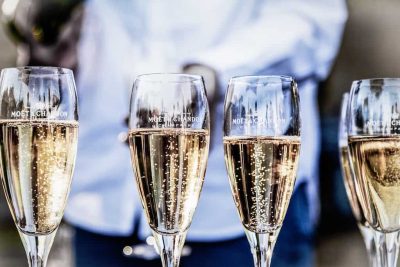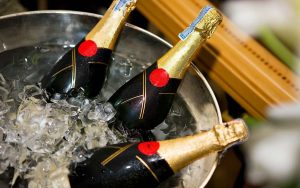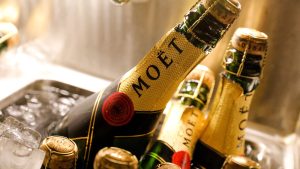Are you wondering if that bottle of champagne in your pantry needs to be refrigerated before popping the cork? Or perhaps you’re planning a special occasion and want to know the best way to store your champagne to ensure it’s perfectly chilled and bubbly when it’s time to celebrate.
In this article, we’ll explore the question on everyone’s mind: Does champagne need to be refrigerated? From the proper storage techniques to the ideal serving temperature, we’ve got all the information you need to keep your champagne in tip-top shape for your next special occasion.
So, grab that bottle and get ready to learn everything you need to know about storing champagne like a pro.
Does champagne need to be refrigerated?
Champagne, like other wines, should be stored in a cool, dark place to preserve its quality and taste. The ideal storage temperature for champagne is between 45 and 55 degrees Fahrenheit. It should also be stored in a horizontal position to keep the cork moist, which helps to prevent air from getting into the bottle and oxidizing the wine.
When it comes to serving champagne, it should be chilled before drinking. The ideal serving temperature for champagne is between 42 and 48 degrees Fahrenheit. To achieve this temperature, champagne can be stored in the refrigerator for a few hours before serving.
It’s worth mentioning that if the bottle has been opened, it is better to finish it within the next day and refrigerate it after opening. Also, sparkling wine and champagnes are sensitive to light and vibration, so storing them in a refrigerator could damage the wine over time.
It is best to find a wine fridge or a cool dark spot to store your champagnes to get the best taste if you’re not going to drink them in the next day or two.
How long can champagne be stored before refrigeration is necessary?
Champagne should be stored in a cool, dark place, ideally at a temperature between 45 and 55 degrees Fahrenheit. Once the bottle is opened, it should be consumed within a few days, as the wine will start to oxidize and lose its effervescence.
Before refrigeration, champagne would be aged in a dark, cold place before release, but once the bottle is open, the same rule applies and should be finished within a few days. Even though refrigeration can slow down the process of oxidation, it’s not essential as long as the wine is kept cool and away from light.
As a general rule, it’s best to consume champagne within a year of the bottling date, as the wine’s flavors and aromas will start to deteriorate after that point. Non-vintage champagnes, which are typically intended to be consumed within a year or two of bottling, will start to lose their freshness and effervescence more quickly than vintage champagnes, which are aged for longer before release.
Does champagne have to be chilled before serving?
Champagne should be served chilled, as serving it at too warm of a temperature can mask the wine’s flavors and aromas and make it less effervescent. The ideal serving temperature for champagne is around 45-50°F (7-10°C).
To properly chill the champagne, it’s best to place the bottle in the refrigerator for at least a few hours or in a bucket of ice and water for 20-30 minutes. You can also store champagnes that you are not going to drink right away in a wine cellar or wine fridge with a temperature range of 42-48 F.
It is not recommended to put a bottle of champagne in the freezer, as the extreme cold can cause the cork to pop out, which can result in the wine being wasted.
In general, chilling the champagne will enhance the aromas and flavors, making the wine more refreshing and enjoyable to drink.
How to properly store champagne to preserve its taste and quality
Proper storage of champagne is essential to preserving the wine’s taste and quality. Here are some tips for storing champagne:
- Keep it cool: Champagne should be stored in a cool, dark place, ideally at a temperature between 45 and 55 degrees Fahrenheit. This temperature range will slow down the process of oxidation and keep the wine fresh.
- Store it upright: Champagne bottles should be stored upright to prevent the cork from drying out and letting air into the bottle. If the cork dries out, it can allow oxygen to enter the bottle and spoil the wine.
- Avoid light: Light can cause a wine to spoil, so champagne bottles should be stored in a dark place or, at least, in a room with low light.
- Keep it steady: Avoid storing champagne bottles in places where they will be jostled around, as this can cause sediment to form in the wine.
- Keep humidity level at an optimal level: champagne bottles should be stored in an area with moderate humidity of around 50-70% to keep the cork from drying out.
- Store the bottles in a wine cellar or a wine fridge if possible. These devices have temperature and humidity control, providing ideal storage conditions.
- If you’ve opened a bottle of champagne, it should be consumed within a few days to prevent the wine from oxidizing and losing its effervescence.
By following these guidelines, you’ll help to ensure that your champagne stays fresh and maintains its quality for as long as possible.
The ideal storage temperature for champagne
The ideal storage temperature for champagne is between 45 and 55 degrees Fahrenheit (7 to 13-degree celsius); this will keep the wine fresh and preserve its taste and quality.
Storing champagne at temperatures above 55 degrees Fahrenheit (13 degrees Celsius) can cause the wine to spoil, as it will accelerate the oxidation process and cause the flavors and aromas to deteriorate.
On the other hand, storing it at a temperature below 45 degrees Fahrenheit (7 degrees Celsius) can cause the wine to lose some of its flavor and aroma; it can also cause the cork to dry out and let air into the bottle.
It’s also important to keep the storage area as steady as possible without too many fluctuations in temperature. And keep in mind that storing in a wine fridge or a wine cellar is the best way to maintain the ideal storage temperature for wine.
Difference between sparkling wine and champagne storage requirements
While sparkling wine and champagne are both carbonated wines, they have different production methods and storage requirements.
Champagne is a sparkling wine that is produced exclusively in the Champagne region of France, using specific grape varieties and production methods. Champagne must be made using the méthode champenoise, a traditional method that involves a secondary fermentation in the bottle, which gives the wine its characteristic bubbles.
Sparkling wine, on the other hand, can be produced anywhere in the world and can be made using a variety of methods, including the méthode champenoise and bulk methods such as the Charmat method or Tank method.
Regarding storage, the key factors to consider are temperature, humidity, light, and vibration.
For both Champagne and sparkling wine, the optimal storage temperature is between 45 to 55 degrees Fahrenheit (7-13 degree Celsius) and should be stored in a cool, dark place with moderate humidity of around 50-70% to prevent the cork from drying out.
Champagne and sparkling wine bottles should also be stored upright to prevent the cork from drying out and should be kept steady and avoid any vibration to prevent sediment formation. Also, they should be protected from any source of light.
When it comes to aging, champagne generally has a longer aging potential compared to sparkling wines, as the grape varieties and the production method used give champagne a better structure to age and evolve.
Non-vintage champagnes, which are typically intended to be consumed within a year or two of bottling, will start to lose their freshness and effervescence more quickly than vintage champagnes, which are aged for longer before release.
Sparkling wine, on the other hand, typically has a shorter aging potential and is meant to be consumed within a year or two of the bottling date. It is not intended to be aged for a long time and may lose some of its flavor and effervescence over time.
Therefore, it’s important to keep in mind that proper storage will help both champagne and sparkling wine to maintain their taste and quality for as long as possible.
The effects of fluctuating temperatures on champagne
Fluctuating temperatures can have a negative effect on champagne and can cause the wine to spoil or lose its quality. Champagne should be stored at a consistent temperature between 45 and 55 degrees Fahrenheit (7 to 13 degrees Celsius), which is the ideal temperature range to slow down the process of oxidation and keep the wine fresh.
Exposure to temperatures above 55 degrees Fahrenheit (13-degree celsius) can cause the wine to spoil. High temperatures can speed up the oxidation process, causing the wine to lose its effervescence and change in flavor and aroma.
So, prolonged exposure to high temperatures can also cause the wine to become cooked, which can make the wine taste unbalanced and can have a negative impact on the wine’s overall quality.
In addition, exposure to temperatures below 45 degrees Fahrenheit (7 degrees Celsius) can also have a negative impact on champagne, as it can cause the wine to lose some of its flavor and aroma and can make it less effervescent. At the same time, it can cause the cork to dry out and allow air to enter the bottle, which can spoil the wine.
Temperature fluctuations can also cause the wine to expand and contract, which can force air into the bottle and cause the wine to spoil. This can also cause the cork to push out or pull in, which can lead to air entering the bottle or wine leaking out.
It’s important to keep champagne stored in a cool, dark place with a steady temperature, wine cellar or wine fridge with a temperature range of 42-48 F is ideal for storing champagne. Avoid storing champagne in places where the temperature frequently fluctuates, such as in a garage or near a window, or near appliances that produce heat.
By keeping champagne stored at a consistent temperature, you can help to ensure that the wine stays fresh and maintains its quality for as long as possible.
The shelf life of opened champagne
The shelf life of an opened bottle of champagne is relatively short, and it should be consumed within a few days to prevent the wine from oxidizing and losing its effervescence. This is because, once the bottle is opened, the wine is exposed to oxygen which can cause the wine to spoil.
After opening the bottle, it is best to keep the bottle sealed with a champagne stopper to slow down the oxidation process. Make sure to store the opened bottle of champagne in a cool, dark place, ideally at a temperature between 45 and 55 degrees Fahrenheit, away from light and any source of heat.
As soon as you open a bottle of champagne, it is important to consume it as soon as possible, as the wine’s flavor and aroma will start to deteriorate after a few days. Some people believe that sparkling wines can be kept open for up to 3-5 days, but the best way to ensure the quality of the wine is to consume it within the first 48 hours after opening.
Difference in taste between refrigerated and non-refrigerated champagne
Champagne is best served chilled, around 45-50°F (7-10°C), as serving it at too warm of a temperature can mask the wine’s flavors and aromas and make it less effervescent. Therefore refrigerating the champagne will enhance the aromas and flavors, making the wine more refreshing and enjoyable to drink.
If champagne is not refrigerated and it’s served at room temperature, it can taste overly warm, and its flavors and aromas will not be as pronounced. The wine may also taste flatter and less effervescent, as the bubbles will have less energy to escape from the wine.
If champagne is refrigerated for too long and served too cold, it can taste overly cold, and flavors and aromas can be suppressed. It is also hard to distinguish the nuances and subtleties of the wine, as the coldness can numb the taste buds.
It’s also worth noting that if you put a bottle of champagne in the freezer, it can cause the cork to pop out and cause the wine to be wasted. The extreme cold can also cause the wine to expand and contract, which can force air into the bottle and cause the wine to spoil.
In short, serving champagne at the right temperature can enhance its flavors and aromas, making it more enjoyable to drink. Storing champagne in a refrigerator, between 45-50°F (7-10°C) for a few hours or in a bucket of ice and water for 20-30 minutes is the best way to get it to the right temperature, but it should be consumed within 48 hours after opening.
How to tell if champagne has gone bad
Champagne can go bad if it is not stored or handled properly or if it has been opened for too long. Here are some signs that can indicate that a bottle of champagne has gone bad:
- The cork is bulging or popping out: If the cork is bulging or popping out, it can be an indication that the wine has been exposed to high temperatures or has been stored incorrectly. This can cause the wine to spoil, as air can enter the bottle and cause the wine to oxidize.
- The wine has a musty or moldy smell: If the wine has a musty or moldy smell, it can be an indication that the cork has been compromised and air has entered the bottle, causing the wine to spoil.
- The wine has lost its effervescence: If the wine has lost its effervescence and is no longer sparkling, it can be an indication that the wine has been stored for too long or that the bottle has been opened for too long.
- The wine has changed color: If the wine has changed color, for example, if it has become darker or has developed a brown tint, it can be an indication that the wine has been exposed to light or heat, causing it to spoil.
- The wine has an off-taste: If the wine has an off-taste, such as being too acidic, too sweet, or having a sour taste, it can be an indication that the wine has spoiled.
It’s worth noting that, in general, even if champagne is stored correctly, it can lose its flavors and aromas, and effervescence over time, specially non-vintage champagnes. It is best to consume champagne within a year of the bottling date, as the wine’s flavors and aromas will start to deteriorate after that point.
If you notice any of these signs, it’s best to discard the wine, as it is no longer safe to consume.
The effects of light and humidity on stored champagne
Light and humidity can have a negative impact on stored champagne, and proper storage can help to protect the wine from these elements.
- Light: Light can cause the wine to spoil, as it can cause the wine to heat up and can cause the wine to develop a brown tint. This is why it is important to store champagne in a dark place, or at least in a room with low light. Direct sunlight should be avoided.
- Humidity: Champagne bottles should be stored in an area with moderate humidity of around 50-70% to keep the cork from drying out; if the cork dries out, it can allow oxygen to enter the bottle and spoil the wine. Storing champagne in a low-humidity environment can cause the cork to dry out, which can also lead to oxidation and spoilage of the wine.
- Temperature: as mentioned before, consistent temperature and cool storage are important for champagne. The ideal storage temperature for champagne is between 45 and 55 degrees Fahrenheit (7 to 13 degrees Celsius), and it should be kept in a consistent and cool place, such as a wine cellar or wine fridge.
By protecting the champagne from light and storing it in an area with moderate humidity and the right temperature, you can help to ensure that the wine stays fresh and maintains its quality for as long as possible.
How to properly store champagne for a special occasion or event
When storing champagne for a special occasion or event, it is important to take into account the factors that can affect the wine’s quality, such as temperature, humidity, light, and vibration. Here are some tips for storing champagne for a special occasion or event:
- Keep it cool: Champagne should be stored in a cool, dark place, ideally at a temperature between 45 and 55 degrees Fahrenheit (7-13 degree Celsius), and should be kept away from any sources of heat. This will slow down the process of oxidation and keep the wine fresh.
- Store it upright: Champagne bottles should be stored upright to prevent the cork from drying out and letting air into the bottle. This can cause the wine to spoil and lose its effervescence.
- Avoid light: Light can cause the wine to spoil, so champagne bottles should be stored in a dark place or at least in a room with low light, such as a wine cellar or a wine fridge.
- Keep it steady: Avoid storing champagne bottles in places where they will be jostled around, as this can cause sediment to form in the wine.
- Keep humidity level at an optimal level: champagne bottles should be stored in an area with moderate humidity of around 50-70% to keep the cork from drying out.
- Plan ahead: store the bottle of champagne in advance; it’s best to store the bottle at least a week before the event so that it has time to reach the ideal serving temperature.
- Choose the right time to open: open the bottle at the right time, ideally just before the guests arrive, and only open the bottles that you plan to serve immediately.
By following these guidelines, you can ensure that your champagne stays fresh and maintains its quality for your special occasion or event.
Recommended:
Conclusion
Do you need clarity on the question does champagne need to be refrigerated? Then you are just in the right place. While refrigeration is not essential for champagne, it is recommended to store and serve the wine chilled in order to enhance the wine’s flavors and aromas and to make it more refreshing and enjoyable to drink.
Champagne should be stored in a cool, dark place, ideally at a temperature between 45 and 55 degrees Fahrenheit. Once the bottle is opened, it should be consumed within a few days as the wine will start to oxidize and lose its effervescence.




